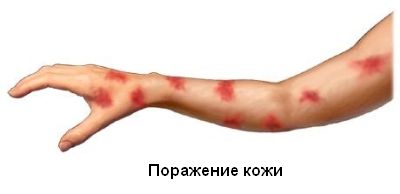Kaposi's Sarcoma
Description of Kaposi's sarcoma
Kaposi's sarcoma is a form of cancer, that affects the blood vessels. It can cause lesions on the skin, mucous membranes or internal organs. Often damage occurs in the gastrointestinal tract and lungs.
Cancer occurs, when the body's cells start to randomly share. The result is a mass of tissue, called a growth or tumor. The term cancer refers to malignant tumors, that can invade nearby tissues and spread to other parts of the body.
KS can be classified according to the group of people, in which it occurs:
- Classical – usually affects men of Mediterranean descent;
- Endyemichyeskaya – usually affects people, living in equatorial Africa;
- Transplant-related (Acquired) – It occurs in people, transplant organs;
- AIDS-related – It occurs in AIDS patients.
The causes Kaposi's sarcoma
In most cases, Kaposi's Sarcoma occurs in humans, patients AIDS. In this group of studies have shown a close relationship between the virus and Kaposi's sarcoma, sexually transmitted, It called human herpesvirus 8. These factors, probably, have the greatest impact. The virus apparently, It is also associated with classic and endemic KS.
Risk factors for Kaposi's sarcoma
Factors, which increase the risk of Kaposi's sarcoma:
- HIV infection;
- Homosexual contacts between men, and sexual contact with bisexual women;
- Supplementation, that suppress the immune system.
The symptoms of Kaposi's sarcoma
The most common symptom is damage to the skin or mucous membranes , that:
- Manifested as a raised spots or nodules;
- Can occur anywhere on the body;
- Have purple, brown, red or pink color;
- May cause swelling and pain.
Other symptoms include:
- Internal bleeding (It develops inside the body);
- Breathing problems (with the defeat of the lungs).

Diagnosis of Kaposi's sarcoma
The doctor will ask about your symptoms and medical history, and perform a physical exam. If you have skin lesions, a doctor can diagnose this disorder detail. If bleeding, pain or weight loss, you may need more tests, to find out, if you have Kaposi's sarcoma.
Tests may include:
- Biopsy – removal of a sample of tissue from a lesion to test for cancer cells;
- CT-type of X-ray, which uses computer, to make pictures of organs inside the body;
- Bronchoscopy – a thin tube is inserted into the throat, to examine the lungs and airways;
- Endoscopy – a thin tube is inserted into the throat, to investigate the gastro-intestinal tract.
The doctor may suspect Kaposi's sarcoma, if you have AIDS and have swollen lymph nodes.
Treatment of Kaposi's sarcoma
Treatment depends on the type of Kaposi's sarcoma. If Kaposi's sarcoma associated with AIDS, Treatment is focused on relieving pain. Treatments include:
Surgery
The operation involves the removal of lesions on the skin and mucous membranes. Surgery to remove internal lesions depends on the size, symptoms and the location of Kaposi's sarcoma.
Because KS can bleed profusely after surgery, the doctor will try to remove the entire affected area with some of the normal tissue around it, to try to reduce bleeding.
Radiation treatment for Kaposi Sarcoma
Radiation used, to kill cancer cells. Therapy is usually held once or in stages within 2-3 weeks. Number of treatments depends on the size and location of the lesion.
Antiretrovirusnaya therapy
The therapy is used to combat HIV and restore immune function. Some patients, While Kaposi Sarcoma, This method of treatment can be very effective.
Chemotherapy sarkomы sarcoma
Chemotherapy – the use of drugs to kill cancer cells. Preparations for the chemotherapy may be given in various forms: tablets, injection, the introduction of a catheter. The drugs enter the bloodstream and spread throughout the body, killing mostly cancer, and also some healthy cells. In some cases the agents may be injected directly into the lesion.
Biological therapy for Kaposi's sarcoma
The method involves the use of drugs or substances, produced by the body. They are used to increase or restore the body's natural defenses against cancer.
Prevention of Kaposi's sarcoma
To prevent Kaposi's sarcoma, AIDS-related, We need to take some steps, to minimize the impact of HIV:
- It is necessary to abstain from sex. If you have sex, use a male latex condom;
- Do not share needles;
- Limit the number of people, in whom you have sex;
- Avoid sexual partners, who have HIV or who use IV drugs;
- Avoid transfusions of unscreened blood and blood products;
- If you are a health worker:
- Wear rubber gloves and face masks;
- Carefully handled and properly dispose of needles;
- Follow universal precautions;
- If you live in a house with an infected person:
- Wear rubber gloves, If there is a possibility of contact with the body fluids;
- Close all cuts and wounds with bandages (and at patient);
- Do not use with patients personal hygiene items;
- Carefully handled and properly dispose of needles.
